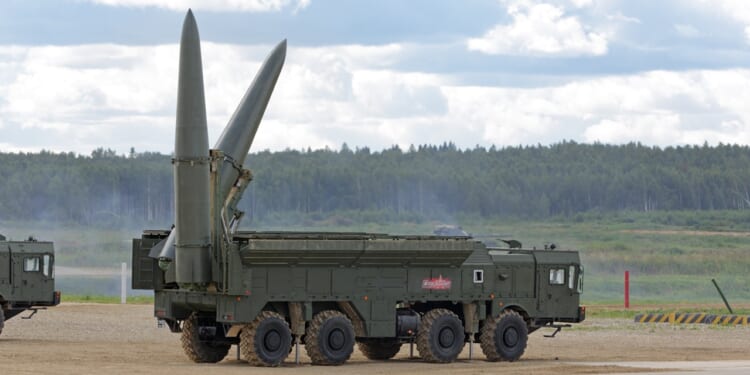A number of new innovations in Russia’s Iskander missiles have stymied Ukrainian air defenses—plunging interception rates to as low as 6 percent.
When my colleague at The American Conservative, Andrew Day, recently returned from a speaking trip to Kyiv, he informed me that the air defenses in Ukraine had become so unreliable that it was “almost as if they didn’t exist.” He reported on how intermittently the vaunted NATO-provided air defenses would deploy against swarms of Russian missiles and drones fired into the night. And these anecdotal stories align well with actual military reports indicating that, since September, the effectiveness of Ukraine’s Western-provided air defenses have precipitously declined from 34 percent to around 6 percent—or even lower.
Specifically, the US-supplied MIM-104 Patriot air defense systems are increasingly struggling to intercept the Russian 9K720 Iskander-M (and similar Russian systems) in Ukraine. Indeed, it is a multifaceted and highly technical set of problems all conspiring to undermine the beleaguered air defenses of Ukraine…and some of those reasons remain a matter of state secrets. But we can glean at least some of the reason for why the air defenses have collapsed in Ukraine.
Although the frontlines of the Ukraine War have, for the last several years, remained relatively static, the tactics and technology the two sides have employed have been quite dynamic. Innovations abound on both sides of the conflict, as the two sides—like two fighters in Vladimir Putin’s favorite martial art of Judo—continually struggle against each other, looking for even the slightest imperfection in their respective defenses with which to exploit and effectively defeat their opponent.
Russia Enjoys the Upper Hand in Missile Warfare
Right now, Russia’s probing and innovation have yielded better results than have the Ukrainians’ attempts. For example, Russia has employed trajectory changes to their Iskander missiles when launching them against targets in Ukraine. Instead of flying the Iskanders on a nice, predictable ballistic arc, the Iskander-M is flying a quasi-ballistic path. The Russian missile might coast normally, then divert, dive steeply, or simply maneuver to its terminal phase, as per reporting in The Kyiv Independent.
The Patriot missile system, like most US missile defense systems—including national missile defense networks, like the Ground-Based Interceptors (GBIs) at Fort Greeley in Alaska—work on predicting the incoming target’s path and intercepting it based on that prediction. When the target suddenly changes its flight path, the software and system of the missile defense interceptor has less time to compute and adjust to intercept. The chances drastically increase, therefore, that the interception will fail.
One report suggests that Russian engineers have equipped their Iskander-Ms with radar-decoy devices that can be ejected by the system on its final approach to the target, further confusing the radar and target-track of American and Western missile defense interceptors. By having false radar returns, it confuses the software on the interceptor and makes it more than likely that the GBI will chase the decoy signal, allowing for the Iskander-M to hit its target.
What’s more, the sudden dives that Iskander-Ms are now taking in their terminal phases are exploiting gaps in the radar systems of the Patriot batteries and are cutting down on its ability to reliably respond to the incoming threat. At the very least, these radical maneuvers ensure that the time between when the Iskander threat is first detected and when the Patriot missiles can respond is shrunk to an almost unmanageable short amount of time.
Beyond the technical matters, there’s the issue of numbers. As in, the Russians’ incredible war economy is constantly churning out their Iskanders and similar offensive platforms like sausages whereas the Ukrainians are reliant upon the brittle US and European industrial bases (or their own besieged industrial base in Ukraine) to meet the ravenous demands of the Ukrainian war machine. Because the American and European arsenals of Patriot missile batteries (and the missiles themselves) are finite, far too few Patriots have been given to the Ukrainians.
Russia Understands the Importance of Saturation Attacks
Thus, when the Russians engage in their swarming tactics, the Ukrainians cannot keep up. This is, of course, the entire purpose of Russia’s saturation attacks against those limited Ukrainian air defenses. Add in these dynamic, quasi-ballistic courses the Iskander-Ms are being fired along, and it becomes clear that the Ukrainians will be unable to keep up with the Russian offensives.
The Patriot system is still capable of intercepting some ballistic missiles, but the Russians have created effective workarounds, reducing the system’s effectiveness. Ukraine and its partners will need more batteries, more interceptors, better coverage, and likely upgraded software and hardware for the Patriots to restore higher interception rates.
All these needs are not coming, though, because the Western defense industrial base is so badly broken and unable to keep up with the Russian wartime economy (that Western policies have ironically helped to create).
For Russia, the cost of these modifications may be lower (software upgrades, tactical changes) than the cost to Ukraine of countering them. This gives Russia serious advantages, at least for now.
Could Ukrainian Tomahawk Missiles Restore Balance?
Russia’s Iskander-M have been successfully modified by Moscow to operate in such a way that Cold War-era American missile defense systems, like the Patriot, cannot keep up. At the same time, Ukraine’s finite number of Patriot batteries and interceptors, as well as radar coverage gaps, are combining to give Russia the edge in their war against Ukraine. As noted, the interception rate for Ukraine has fallen from 34 percent to 6 percent in the last 60 days. Unless an immediate, radical change is made, these numbers will continue to collapse—and Ukraine’s ability to wage the war along with it.
In this context, then, it becomes clear why Kyiv is demanding access to large numbers of American Tomahawk cruise missiles. If Kyiv cannot protect its airspace against these Russian missiles, then Zelenskyy will attempt to further threaten Russian territories with increasingly advanced strike weapons from the United States, such as the Tomahawk.
That, too, will not work—because the Russians have fundamentally overmatched the Ukrainian Armed Forces as well as their Western backers, draining Ukraine and the West of personnel, arms, and money that will be far too difficult to replace in a meaningful timeline.
About the Author: Brandon J. Weichert
Brandon J. Weichert is a senior national security editor at The National Interest. Recently, Weichert became the host of The National Security Hour on America Outloud News and iHeartRadio, where he discusses national security policy every Wednesday at 8pm Eastern. He is also a contributor at Popular Mechanics and has consulted regularly with various government institutions and private organizations on geopolitical issues. Weichert’s writings have appeared in multiple publications, including The Washington Times, National Review, The American Spectator, MSN, and the Asia Times. His books include Winning Space: How America Remains a Superpower, Biohacked: China’s Race to Control Life, and The Shadow War: Iran’s Quest for Supremacy. His newest book, A Disaster of Our Own Making: How the West Lost Ukraine is available for purchase wherever books are sold. He can be followed via Twitter @WeTheBrandon.
Image: Shutterstock / ID1974.

















